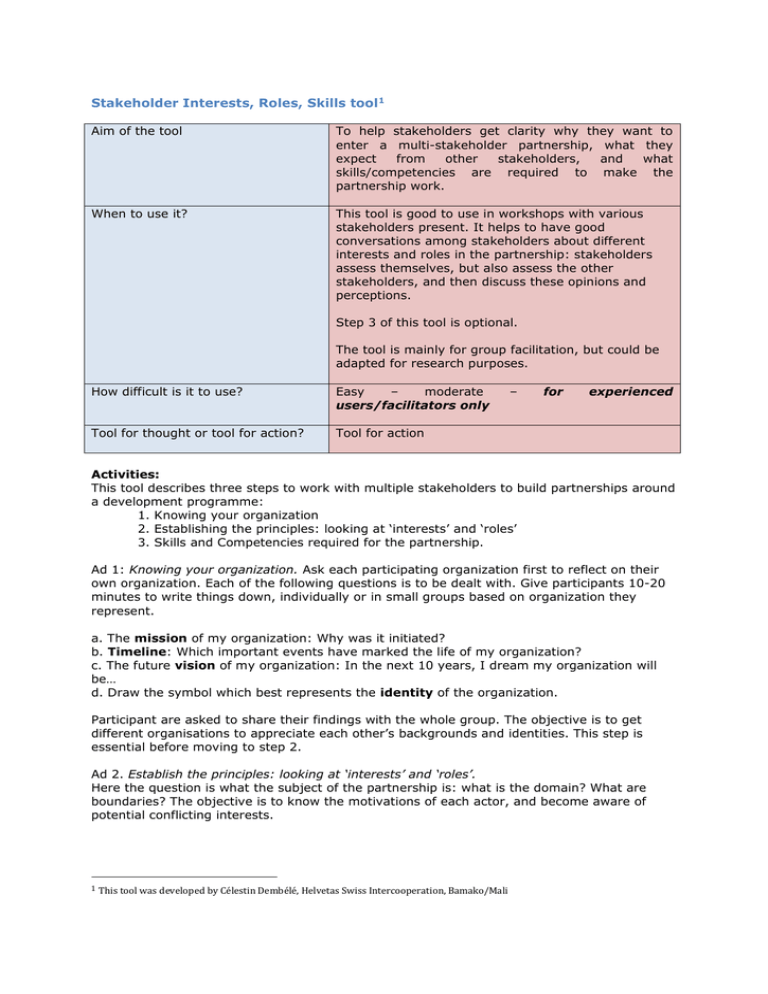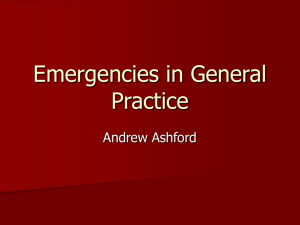an overview of this tool - Multi
advertisement

Stakeholder Interests, Roles, Skills tool1 Aim of the tool To help stakeholders get clarity why they want to enter a multi-stakeholder partnership, what they expect from other stakeholders, and what skills/competencies are required to make the partnership work. When to use it? This tool is good to use in workshops with various stakeholders present. It helps to have good conversations among stakeholders about different interests and roles in the partnership: stakeholders assess themselves, but also assess the other stakeholders, and then discuss these opinions and perceptions. Step 3 of this tool is optional. The tool is mainly for group facilitation, but could be adapted for research purposes. How difficult is it to use? Easy – moderate users/facilitators only Tool for thought or tool for action? Tool for action – for experienced Activities: This tool describes three steps to work with multiple stakeholders to build partnerships around a development programme: 1. Knowing your organization 2. Establishing the principles: looking at ‘interests’ and ‘roles’ 3. Skills and Competencies required for the partnership. Ad 1: Knowing your organization. Ask each participating organization first to reflect on their own organization. Each of the following questions is to be dealt with. Give participants 10-20 minutes to write things down, individually or in small groups based on organization they represent. a. The mission of my organization: Why was it initiated? b. Timeline: Which important events have marked the life of my organization? c. The future vision of my organization: In the next 10 years, I dream my organization will be… d. Draw the symbol which best represents the identity of the organization. Participant are asked to share their findings with the whole group. The objective is to get different organisations to appreciate each other’s backgrounds and identities. This step is essential before moving to step 2. Ad 2. Establish the principles: looking at ‘interests’ and ‘roles’. Here the question is what the subject of the partnership is: what is the domain? What are boundaries? The objective is to know the motivations of each actor, and become aware of potential conflicting interests. 1 This tool was developed by Célestin Dembélé, Helvetas Swiss Intercooperation, Bamako/Mali The first step is to ask organisations present to fill out the ‘interests’ table, followed by the ‘roles’ table. This is done individually, focusing on what participants believe to be their organisations’ interests and roles. Interests Who could be our ally? Why? Who could be our competitor? Why? Interest 1 Interest 2 Interest 3 Roles Actor 1 Actor 2 Actor n Actor 1 Actor 2 Actor n After each organization has filled out these two tables for their own organization, ask them to repeat the exercise but defining what s/he believes to be the interest and roles of others. In plenary, we then look for consensus on everyone’s agreed upon roles. These can be considered principles, or a ‘social contract’. Ad 3. Competencies required for the partnership In this third step participants reflect on the necessary skills and competencies to perform the different roles and functions in their organisations. By using a table this can be made visible. Here is an example: Role ULFBV (breeders) Dissemination of SP information and other texts Required skills Qualities needed Transparency and reliability Participation in the identification of rules, tracks and sites DLCA (Chamber of agriculture) Advocating that the state structures to comply with the provisions of the SP Conflict management at the local level Council circle (community) Project management of development processes (intermunicipal consultations, forum, evaluation…) Following up major intermunicipal actions Knowledge of the pastoral charter, of SP and other texts Ability to explain the texts In-depth knowledge of the problems of pastoralism Locating the routes and sites to develop Serious interest in each site Knowing to apply advocacy techniques Partnering with other resource people of the OP in the advocacy Knowing the tradition Knowing the local land agreements and conventions Being able to bring people together in negotations and mediations Respecting the law Defining the concept of MO (stages, roles…) Applying the provisions of the employer Credibility Taking responsibility Lead a monitoring committee Mastering monitoring and evaluation tools Developing a monitoring and evaluation report Critical mindset Availability Level 0 : Our organisation does not know how to do it / not well Level 1 : Our organisation is able to with external assistance Level 2 : Our organisation has done it multiple times without external assistance Level 3 : Our organisation has trained others in this area Then, assess how well each skill is mastered in your organization. Do this by providing participants with a spider diagram, consisting of as many spokes as there are skills required (eg. 6 skills, then a wheel with 6 spokes). On each spoke, indicate levels starting with 0 from the centre to 3 on the outskirts of the spoke. Each participant gives scores per skill, using the following criteria: Use the following table to help participants diagnose the levels of skills/competencies: Skill Level of the organisation Evidence (only level 2 and 3) Number of competent people Skill 1 Skill 2 Lastly, reflect on ‘What do I need to strengthen?’ This includes clarifying whose responsibility it is to strengthen skills and competencies. This can be aided by the following table: Skills domain What (what needs to be strengthened ?) Who (People concerned, number, profile) How (capacity building method) When (favorable timing)






